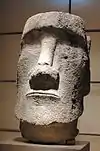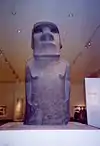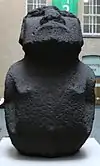Relocation of moai objects
Since the removal of the first moai Hoa Hakananai'a from Easter Island in 1868 by the crew of HMS Topaze, 79 complete moai, heads, torsos, pukao, and moai figurines are also known to have been removed from their original sites, and transferred to either private collections,[1] the collections of museums (including the Museo Arqueological Padre Sebastian Englert on Easter Island),[2] or, most recently to the university grounds of the American University, Washington D.C. in 2000.[3] Some of the moai have been further transferred between museums and private collections, for reasons such as the moais' preservation, academic research and for public education, or – in the instance of the moai from Centro Cultural Recoleta – for repatriation after 80 years overseas.[4]
Objects in museum collections
The following table lists the most prominent figures held in museums and collections:
| Object | Material | Height | Current location | Country | Acquisition Date | Reference[5] | Notes | Image |
|---|---|---|---|---|---|---|---|---|
| Moai | Basalt | 3 m | Royal Museums of Art and History, Brussels | Belgium | 1934-35 | ET.35.5.340 or Pou hakanononga | Removed by the Lavachery, Metraux and Watelin expedition. |  |
| Unnamed Moai | Rapa Nui | (Easter Island) | Removed from Hanga Roa in 1929 spent 40 years in Santiago, Chile before being transported to Argentina and making a round trip to the Netherlands. It was returned to Rapa Nui in 2006.[6] | |||||
| Moai | Tuff | 2.94 m | Salón de la Polinesia, Museo arqueologico, La Serena | Chile | Displayed in Europe, then moved to the Salón de la Polinesia |  | ||
| Moai | Tuff | 2.81 m | Corporacion Museo de Arqueologia e Historia Francisco Fonck, Viña del Mar | Chile | 1174 (EISP# MF-VDM-001) |  | ||
| Head | Basalt | Corporacion Museo de Arqueologia e Historia Francisco Fonck, Viña del Mar | Chile | 35-001 (EISP# MF-VDM-002) | ||||
| Moai | Tuff | 2.88 m | Museo Arqueological Padre Sebastian Englert, Hanga Roa, Rapa Nui | (Easter Island) | MA-IDP025 | |||
| Head | Tuff | 2 m (approx) | Museo Arqueological Padre Sebastian Englert, Hanga Roa, Rapa Nui | (Easter Island) | c. 2006 | Moai from Centro Cultural Recoleta. | ||
| Pukao | Red scoria | — | Museo Arqueological Padre Sebastian Englert, Hanga Roa, Rapa Nui | (Easter Island) | c. 2006 | Pukao from Centro Cultural Recoleta. | ||
| Head | Tuff | 1.85 m | Musée du quai Branly – Jacques Chirac, Paris | France | 1872 | Formerly presented in the Musée de l'Homme, then removed to the new musée du quai Branly.[7] | ||
| Head | Tuff | 1.70 m | Pavillon des Sessions, Musée du Louvre, Paris | France | c. 1934-35 | MH.35.61.1 | Presented to the Chilean government by Henri Lavachery and Alfred Metraux for the Musée de l'Homme after their expedition to Rapa Nui, in 1934-35. |  |
| Head | Red scoria | 0.42 m | Pavillon des Sessions, Musée du Louvre, or the Musee de l'Homme, Paris | France | c. 1934-35 | MH.35.61.66 | ||
| Head | Basalt | 0.585 m | Auckland Museum, Auckland | New Zealand | AM12768 | |||
| Moai | Trachyte | 1.6 m | Otago Museum, Dunedin | New Zealand | 1929 | D29.6066 | Bought by the museum in 1929 from Norman Brander[8] Museum blog post (with photo) [9] |  |
| Moai | Basalt | 2.42 m | The British Museum, London | United Kingdom | 7 November 1868 | 1869.10-5.1 Hoa Hakananai'a | see article Hoa Hakananai'a |  |
| Moai | Basalt | 1.56 m | The British Museum, London | United Kingdom | 7 November 1868 | 1869.10-6.1 Moai Hava | In the British Museum's Oceanic collection |  |
| Moai | Lapilli tuff | 2.24 m | Department of Anthropology, National Museum of Natural History, Smithsonian Institution, Washington D.C. | United States | 1886 | E128368-0 (EISP# SI-WDC-001) | Removed from Ahu O'Pepe. |  |
| Head | Tuff | 1.194 m | Department of Anthropology, National Museum of Natural History, Smithsonian Institution, Washington D.C. | United States | 1886 | E128370-0 (EISP# SI-WDC-002) | Removed from Ahu O'Pepe. | |
| Pukao | Red scoria | 1.016 m | Department of Anthropology, National Museum of Natural History, Smithsonian Institution, Washington D.C. | United States | 1886 | E128369-0 (EISP# SI-WDC-003) | Removed from Ahu O'Pepe. | |
| Moai | 2 m (approx) | The American University, Washington D.C | United States | 2000 | Moai at the American University | Presented in 2000 by the Embassy of Chile as a gift to The American University. The moai is a replica and displays a pair of reconstructed eyes.[10][11] | ||
Issues of authenticity
The issue of authenticity of Moai heads may never be fully resolved. The fact is that the rocks used to carve the heads are as old as the volcano eruption that formed them, so carbon 14 testing reveals no evidence of authenticity. The age of the Moai heads on the island cannot be determined, and off the island, heads can only be determined to be made from Easter Island volcanic rock or not made from Easter Island volcanic rock. Determining the age of an Easter Island Moai head is therefore an art, and not a science. Field experts make judgments and express opinions about what tools they feel were used and attempt to tie an age to that opinion. Such a condition means that Moai Heads cannot be tested with hope of determining authenticity; they may, however, be brought under suspicion of being fakes. As with any object of antiquity, the patrimony, the history and story of the heads, is an important part in determining authenticity.
An unauthenticated moai head entitled "Henry" currently stands in the Forest Lawn Memorial Park, Glendale, California. It was obtained in the first half of the 20th century by the founder of the park Dr. Hubert Eaton. Dr. Eaton received the moai in a legal transaction between Rapanui fishermen at Easter Island who were using the head (approx 1m height) as ballast for a boat.[12] The Memorial Park has no plans for authenticating or testing the moai in the near future.
In 2003, the Chilean government began an investigation into two moai heads within a set of 15 other Easter Island artefacts[13] — the possessions of Hernan Garcia de Gonzalo Vidal — which were put on sale at The Cronos gallery in Miami. After a photographic inspection by Patricia Vargas, an archaeologist at the University of Chile's Easter Island institute, she commented that ""They might be nice art pieces, but I doubt any one is 500 years old. It appears that the cuts have been made with modern machinery and not with stone tools." A meeting arranged between the Chilean newspaper El Mercurio which first reported the sale, and Hernan Garcia Gonzalo de Vidal, later failed to take place when Mr Gonzalo de Vidal became unavailable due to a "family emergency".[14]
Replicas
In 1968, a moai (possibly Moai 35-001) was taken from Rapa Nui and displayed in New York City as a publicity stunt to oppose the building of a jet refueling facility on Easter Island.[15][16][17] Around the time of the campaign and the following tour to Washington D.C. and Chicago, the moai was received by the Lippincott company of North Haven, Connecticut, which since its inception in 1966 had provided a "place for artists to create large sculptures and receive help in transportation and installation of their work".[18] In co-operation with the International Fund for Monuments Inc, Lippincott produced a copy from the original moai (before it was confiscated by the Chilean government) and claimed the rights to execute the work on 100 further replicas.
In 1974, Object No. 3 was produced from the copy, and now stands outside the Natural History Museum of Los Angeles County.
A group of seven replica Moai arranged in an Ahu exist in the city of Nichinan, Miyazaki Prefecture on the Japanese island of Kyushu. The statues were built and installed in 1996 for the opening of the seaside park Sun Messe Nichinan, of which the statues are the park's centrepiece. As of 2021, the seven statues are the only officially sanctioned replicas in the world.[19]
Notes and references
- The Otago Museum
- Van Tilburg, Jo Anne, (2006), Remote Possibilities: Hoa Hakananai'a and HMS Topaze on Rapa Nui. British Museum Research Papers.
- The American University
- The Age (April 18, 2006). "Easter Island statue heads home".
- The Entries within parenthesis (EISP#) refer to strings assigned by The Easter Island Statue Project Archived 2007-09-07 at the Wayback Machine.
- Easter Island statue heads home - In Depth - theage.com.au
- http://www.quaibranly.fr/uploads/media/Communique_de_presse_croise_DEF.pdf
- Otago Museum
- http://otagomuseum.nz/blog/otago-museum-moai
- Welcome to American University, Washington, DC USA
- The Moai sur Flickr : partage de photos
- Lapidary Journal, (November/December 1954) "The story behind Henry".
- Porteous, Clinton. BBC News (January 7, 2003) "Chile probes Easter Island artefacts".
- Franklin, Jonathan. The Guardian, (January 11, 2003), "Mystery looms over stone heads".
- Glueck, Grace. New York Times, (October 22, 1968) "5-Ton Head From Easter Island is put on a Pedestal".
- Slonim, Jeffrey. Madison Magazine, (1999), "Site Specific".
- Holmes, Greg. The Lope, (April 15, 2006) "Happy Easter Island", correspondence with Samuel Adams Green.
- Smithsonian archives of American art. (September 23, 2007) List of Collections and Interviews A-Z.
- "Sun Messe Nichinan". Atlas Obscura. Retrieved 2021-01-11.